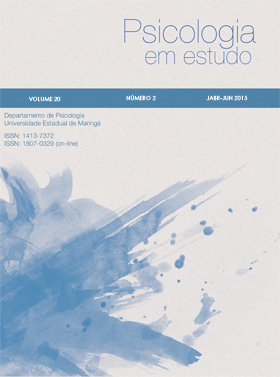USO DE HISTÓRIAS SOCIAIS EM SALA DE AULA PARA CRIANÇAS COM AUTISMO
Resumo
Indivíduos com o Transtorno do Espectro do Autismo (TEA) podem apresentar déficits em comportamentos sociais, como linguagem e interações interpessoais. Intervenções utilizando histórias sociais têm mostrado resultados promissores no ensino de comportamentos socialmente adequados e na redução de comportamentos socialmente inadequados em sala de aula, entre outros ambientes. Histórias sociais são personalizadas a partir do repertório comportamental de cada criança e apresentam as contingências de reforçamento envolvidas no comportamento desejado, no próprio ambiente em que o comportamento ocorre. O objetivo deste estudo foi verificar os efeitos da apresentação de histórias sociais na aprendizagem de comportamentos adequados e na redução de comportamentos inadequados de crianças com TEA em sala de aula. Os participantes foram dois meninos de seis e nove anos de idade, com diagnóstico de TEA, que apresentavam comportamentos inadequados diante de demanda social em ambiente escolar. Comportamentos-alvo para cada participante foram inseridos nas histórias sociais que mostravam as contingências do comportamento inadequado e da resposta alternativa adequada. Antes do início do período em que os comportamentos ocorriam com maior frequência, as histórias foram lidas para as crianças e as frequências dos comportamentos-alvo foram registradas durante a aula. Comportamentos adequados eram reforçados e os inadequados eram seguidos de procedimentos de correção. Os resultados indicaram aumento nos comportamentos adequados e diminuição nos inadequados para os dois participantes, e a diminuição da frequência de outros comportamentos inadequados não tratados diretamente na história social como efeito do engajamento em repertórios adequados de participação nas tarefas em sala de aula. Portanto, as histórias sociais parecem representar uma estratégia promissora na redução de comportamentos inadequados e aumento de adequados em sala de aula, com tempo curto de aplicação e baixo custo de construção dos materiais utilizados.
Downloads
Referências
American Psychiatric Association (APA) (2014). Diagnostic and Statistical Manual of Mental Disorders: DSM-5, tradução: Maria Inês Corrêa Nascimento…et al.; revisão técnica: Aristides Volpato Cordioli [et al.]. - Porto Alegre: Artmed.
Chan, J. M. & O’Reilly, M. F. (2008). A Social Storiestm intervention package for students with autism in inclusive classroom settings. Journal of Applied Behavior Analysis, 41 (3), 405–409.
Cooper, J. O., Heron, T. E., & Heward, W. L. (2007). Applied behavior analysis (2nd Ed.). Upper Saddle River, NJ: Pearson.
Cozby, P. C. (2014). Métodos de pesquisa em ciência do comportamento. São Paulo: Atlas.
Del Prette, Z. A. P. & Del Prette, A. D. (2005). Psicologia das Habilidades Sociais na Infância: teoria e prática. Petrópolis: Vozes.
Freitas, L. C. & Del Prette, Z. A. P. (2013). Habilidades sociais de crianças com diferentes necessidades educacionais especiais: Avaliação e implicações para intervenção. Avances en Psicología Latinoamericana, 31(2), 344-362.
Friman, P. C. (1990). Nonaversive treatment of high-rate disruptions: Child and provider effects. Exceptional Children, 57, 64–69.
Gray, C.A (2000). The new social storybook. Arlington, TX: Future Horizons.
Kuoch, H. & Mirenda, P. (2003). Social Story Interventions for Young Children with Autism Spectrum Disorders. Focus on autism and other developmental disabilities, 18 (4), 219 – 227.
Lorimer, P., Simpson, R., Myles, B. S., & Ganz, J. (2002). The use of social stories as a preventative behavioral intervention in a home setting with a child with autism. Journal of Positive Behavior Interventions, 4, 53–60.
Michael, J. (1982). Distinguishing between discriminative and motivational functions of stimuli. Journal of the Experimental Analysis of Behavior, 37, 149-155.
Mousinho, R., Schmid, E., Mesquita, F., Pereira, J., Mendes, L., Sholl, R., & Nóbrega, V. (2010). Mediação escolar e inclusão: revisão, dicas e reflexões. Revista Psicopedagogia, 27(82), 92-108.
Schlosser, R. W. & Sigafoos, J. (2011). Augmentative and Alternative Communication. In J. K. Luiselli (org), Teaching and Behavior Support for Children and Adults with Autism Spectrum Disorder: a Practitioner’s Guide. New York: Oxford University Press (pp. 91-96).
Skinner, B. F. (1957). Verbal Behavior. Cambridge, MA: B. F. Skinner Foundation.
Thiemann, K. S., & Goldstein, H. (2001). Social stories, written text cues, and video feedback: Effects on social communication of children with autism. Journal of Applied Behavior Analysis, 34, 425– 446.
Vollmer, T. R., Roane, H. S., Ringdahl, J. E., & Marcus, B. A. (1999). Evaluating treatment challenges with differential reinforcement of alternative behavior. Journal of Applied Behavior Analysis, 32, 9–23.
As opiniões emitidas, são de exclusiva responsabilidade do(s) autor(es). Ao submeterem o manuscrito ao Conselho Editorial de Psicologia em Estudo, o(s) autor(es) assume(m) a responsabilidade de não ter previamente publicado ou submetido o mesmo manuscrito por outro periódico. Em caso de autoria múltipla, o manuscrito deve vir acompanhado de autorização assinada por todos os autores. Artigos aceitos para publicação passam a ser propriedade da revista, podendo ser remixados e reaproveitados conforme prevê a licença Creative Commons CC-BY.
The opinions expressed are the sole responsibility of the author (s). When submitting the manuscript to the Editorial Board of Study Psychology, the author (s) assumes responsibility for not having previously published or submitted the same manuscript by another journal. In case of multiple authorship, the manuscript must be accompanied by an authorization signed by all authors. Articles accepted for publication become the property of the journal, and can be remixed and reused as provided for in theby a license Creative Commons CC-BY.
















